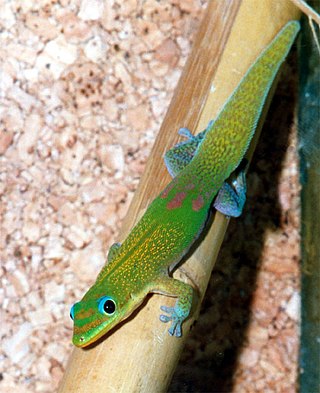
Geckos are small, mostly carnivorous lizards that have a wide distribution, found on every continent except Antarctica. Belonging to the infraorder Gekkota, geckos are found in warm climates throughout the world. They range from 1.6 to 60 centimetres.

The Turkish Van is a semi-long-haired, standardised breed of domestic cat, which was developed in the United Kingdom from a selection of cats obtained from various cities of modern Turkey, especially southeast Turkey. The breed is rare, is one of the larger breeds, and is distinguished by the Van pattern, where the colour is restricted to the head and the tail, and the rest of the cat is white; this is due to the expression of the piebald white spotting gene, a type of partial leucism. A Turkish Van may have blue or amber eyes, or be odd-eyed.

The Himalayan, is a breed or sub-breed of long-haired cat similar in type to the Persian, with the exception of its blue eyes and its point colouration, which were derived from crossing the Persian with the Siamese. Some registries may classify the Himalayan as a long-haired sub-breed of Siamese, or a colorpoint sub-breed of Persian. The World Cat Federation has merged them with the Colorpoint Shorthair and Javanese into a single breed, the Colorpoint.
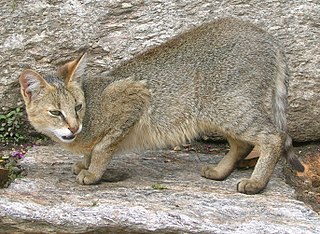
The jungle cat, also called reed cat, swamp cat and jungle lynx, is a medium-sized cat native to the Middle East, the Caucasus, South and Southeast Asia and southern China. It inhabits foremost wetlands like swamps, littoral and riparian areas with dense vegetation. It is listed as Least Concern on the IUCN Red List, and is mainly threatened by destruction of wetlands, trapping and poisoning.

Mushroom hunting, mushrooming, mushroom picking, mushroom foraging, and similar terms describe the activity of gathering mushrooms in the wild, typically for culinary use, though medicinal and psychotropic uses are also known. This practice is popular throughout most of Europe, Australia, Japan, Korea, parts of the Middle East, and the Indian subcontinent, as well as the temperate regions of Canada and the United States.

The Rodrigues day gecko, also known commonly as the Rodrigues blue-dotted day gecko, is an extinct species of day gecko, a lizard in the family Gekkonidae. The species was endemic to the island of Rodrigues, where it typically inhabited forests and dwelt in trees. The Rodrigues day gecko fed on insects and nectar.
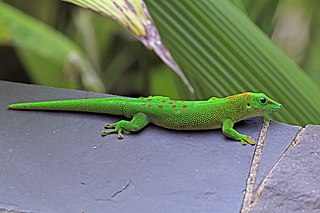
Phelsuma grandis is a diurnal arboreal species of day gecko. These geckos are part of the Phelsuma group, which consists of in excess of 70 species and subspecies. They are commonly referred to as the Madagascar giant day gecko, due to their large size. They are native to areas of tropical and subtropical forest in northern Madagascar, but have been introduced to several other subtropical locations outside their range. P. grandis feeds on various invertebrates, very small vertebrates, and nectars. It is bred and sold as an exotic pet.

Naultinus is a genus of geckos that are endemic to New Zealand. On account of their striking colouration, species in the genus Naultinus are commonly known as green geckos. There are nine described species in the genus. Species in the genus share a number of traits that set them apart as quite different from the rest of the world's two thousand odd gecko species, which are generally brown in colour, ovivaparous, short-lived and nocturnal. In contrast, Naultinus are green, ovovivaparous, live up to 30 years or more and are strictly diurnal. New Zealand has a temperate, maritime climate, and in terms of distribution Naultinus is one of the southernmost gecko genera in the world — some species live in habitats in the South Island which receive regular snowfall in winter. Animals in this genus possess several physiological and behavioural adaptations to cope with these periods of low temperatures and adverse weather.
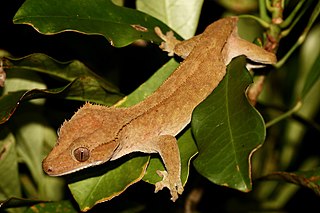
The crested gecko or eyelash gecko is a species of gecko native to southern New Caledonia (France). In 1866, the crested gecko was described by French zoologist Alphonse Guichenot. This species was thought to be extinct until it was rediscovered in 1994 during an expedition led by Robert Seipp. Along with several other New Caledonian gecko species, it is being considered for protected status by the Convention on the International Trade in Endangered Species of Wild Flora and Fauna.

Rhacodactylus leachianus, commonly known as the New Caledonian giant gecko,Leach's giant gecko,Leachianus Gecko, or simply Leachie, is a large species of gecko in the family Diplodactylidae. The species, which was first described by Georges Cuvier in 1829, is endemic to New Caledonia.

The green peafowl or Indonesian peafowl is a peafowl species native to the tropical forests of Southeast Asia and Indochina. It is the national bird of Myanmar. Formerly common throughout Southeast Asia, only a few isolated populations survive within Cambodia and adjacent areas of Vietnam. It has been listed as endangered on the IUCN Red List since 2009, primarily due to widespread deforestation, agriculture and loss of suitable habitat, severely fragmenting the species' populations and contributing to an overall decline in numbers. Due to their natural beauty, they are still sometimes targeted by the pet trade, feather collectors, and even by hunters for meat. They are a much-desired bird for private and home aviculturists, despite their rather high-maintenance care requirements.

The tokay gecko is a nocturnal arboreal gecko in the genus Gekko, the true geckos. It is native to Asia and some Pacific Islands.

The Savannah is a breed of hybrid cat developed in the late 20th century from crossing a serval with a domestic cat. This hybridization typically produces large and lean offspring, with the Serval's characteristic large ears and markedly brown-spotted coats. F1 and F2 male Savannahs can be very large, and in 2016 an F2 male attained a world record for tallest cat at 48.4 centimetres (19.1 in). Show-eligible F4–F5 cats range from 5.0 to 8.2 kilograms however, comparable in size to other large domestic cat breeds such as the Maine Coon or Norwegian Forest cat.

The milky stork is a stork species found predominantly in coastal mangroves around parts of Southeast Asia. It is native to parts of Cambodia, Vietnam, Malaysia and Indonesia. They were once part of the genus Ibis, but is currently included in the genus Mycteria, due to similarities with other storks in that genus.
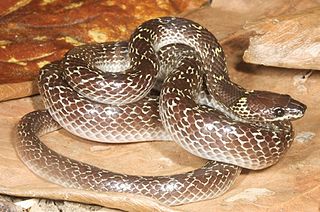
Lycodon capucinus, also known as the Oriental wolf snake, is a species of colubrid snake, which is commonly found in the Indo-Australian Archipelago. Named after their enlarged front teeth, which gives them a muzzled appearance similar to canines, it also makes the snout somewhat more squarish than other snakes.
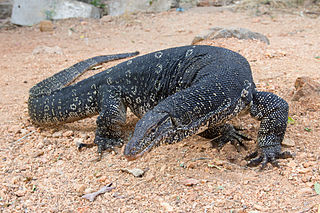
The Asian water monitor is a large varanid lizard native to South and Southeast Asia. It is one of the most common monitor lizards in Asia, ranging from coastal northeast India, Bangladesh, Sri Lanka, mainland Southeast Asia, and southern China to Indonesian islands where it lives close to water. It is listed as Least Concern on the IUCN Red List. It was described by Laurenti in 1768 and is among the largest squamates in the world.

The common house gecko is a gecko native to South and Southeast Asia. It is also known as the Asian house gecko, Pacific house gecko, wall gecko, house lizard, chipkali or moon lizard.

Boiga jaspidea commonly known as the jasper cat snake is a species of rear-fanged colubrid that is uncommon throughout its range.
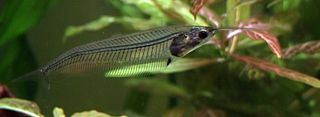
Kryptopterus vitreolus, known in the aquarium trade traditionally as the glass catfish and also as the ghost catfish or phantom catfish, is a small species of Asian glass catfish. It is commonly seen in the freshwater aquarium trade, but its taxonomy is confusing and was only fully resolved in 2013. It is endemic to Thailand, and found in rivers south of the Isthmus of Kra that drain into the Gulf of Thailand and river basins in the Cardamom Mountains. There are also unconfirmed reports from Penang in Malaysia.





















